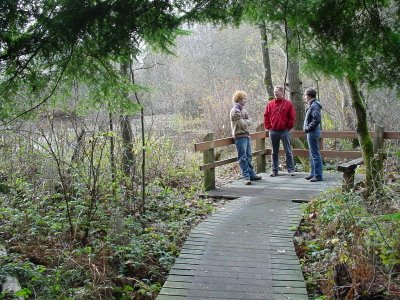 Our hiking destination on Saturday was the West Hylebos Wetland State Park in South King County. Taraz and Megan joined us for the stroll, which is a mile-long boardwalk through forest wetlands right in the middle of a large metropolitin community - Federal Way.
Our hiking destination on Saturday was the West Hylebos Wetland State Park in South King County. Taraz and Megan joined us for the stroll, which is a mile-long boardwalk through forest wetlands right in the middle of a large metropolitin community - Federal Way.  Because of heavy precipitation, the boards are covered with a heavy mesh wire, to prevent slipping this time of year. Everything is mossy and wet. We've had tremendous wind damage over the last couple of days, and this urban forest suffered some heavy damage.
Because of heavy precipitation, the boards are covered with a heavy mesh wire, to prevent slipping this time of year. Everything is mossy and wet. We've had tremendous wind damage over the last couple of days, and this urban forest suffered some heavy damage.  Large cedars had blown over, exposing their shallow roots, blocking the trail. In a few places we had to climb over strewn debris that blocked the trail.
Large cedars had blown over, exposing their shallow roots, blocking the trail. In a few places we had to climb over strewn debris that blocked the trail.This 69 acre wetland has a 20 foot deep peat bog that was formed 10,000 to 15,000 years ago in a depression left after the last glaciation.
 It was fenced off, but that didn't stop Taraz from trying to fish out a few floating beer cans that hikers had tossed into the water. Megan and I warned him to be careful, and she and I held our breath as he tried to fish them out of the water with a stick! ( I could just imagine him toppling head first into those black waters and never coming out again.) He retrieved a number of cans and some plastic paper that was tossed in there. But, we had to leave all of it under a bench since we had no way to carry all the items.
It was fenced off, but that didn't stop Taraz from trying to fish out a few floating beer cans that hikers had tossed into the water. Megan and I warned him to be careful, and she and I held our breath as he tried to fish them out of the water with a stick! ( I could just imagine him toppling head first into those black waters and never coming out again.) He retrieved a number of cans and some plastic paper that was tossed in there. But, we had to leave all of it under a bench since we had no way to carry all the items.We hoped that the work crews - Friends of the Hylebos Wetlands - serving the park will pick the trash up. This organization is the leading community voice for conservation and restoration of the Hylebos Creek Watershed. Since the late 1970's salmon populations of Chinook, coho and chum salmon, and steelhead trout, have been greatly reduced. This organization works with the community to restore the health of the habitat, by involving volunteers and schools, local governments and businesses. Water quality monitoring, tree planting, cleanup and salmon spawning surveys are part of the conservation program. They also have created interpretative signposts along the way to highlight the native flora and fauna. Anyone walking along gains an appreciation for the diversity within this little habitat.
Once we finished the boardwalk, we hiked over to Brook Lake.
 It was nestled in the woods, quite a small tranquil spot. A tiny stream flowed out of the end of it, down into the forest. This is the area of the Hylebos Creek Watershed, which at one time was compromised due to development and population. The heavy use of asphalt in the area has caused the course of stream to change, altering the natural habitat. Industrial activity in the lower watershed polluted and destroyed key habitat for juvenile fish and returning spawners.
It was nestled in the woods, quite a small tranquil spot. A tiny stream flowed out of the end of it, down into the forest. This is the area of the Hylebos Creek Watershed, which at one time was compromised due to development and population. The heavy use of asphalt in the area has caused the course of stream to change, altering the natural habitat. Industrial activity in the lower watershed polluted and destroyed key habitat for juvenile fish and returning spawners. It has taken over seven years to secure the legislation that will protect this area. Friends of the Hylebos Wetlands, with over 800 volunteers, have contributed more than 3,500 hours of volunteer labor for the watershed. Our family really appreciated that, when we strolled, examined, climbed, and enjoyed our little stroll. In our rapidly urbanizing areas here, it is fortunate these conservationists had a strategic plan for habitat preservation. We benefit.